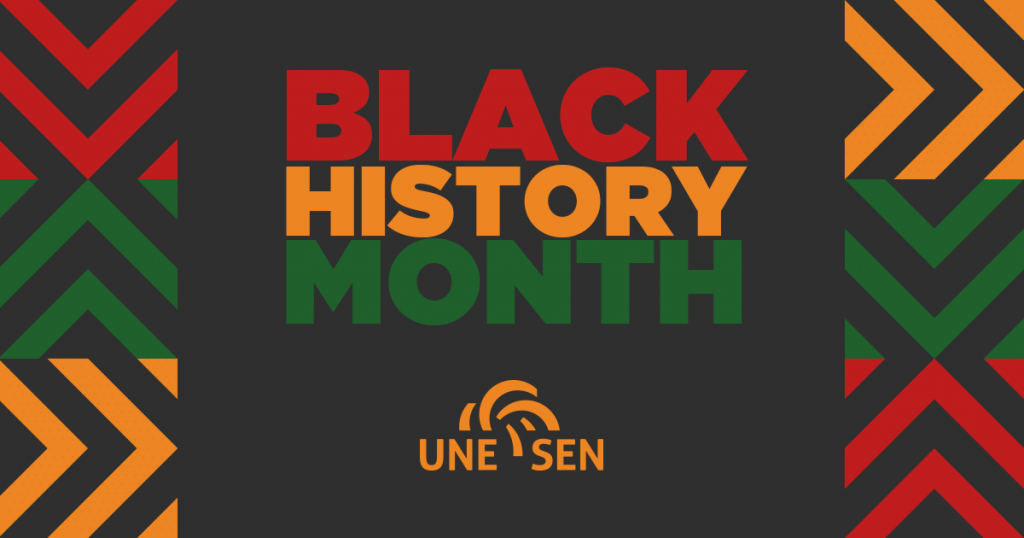
February 9, 2021
As we are celebrating Black History Month, we invite you to take this quiz by UNE National Equity Representative for Racially Visible People Hayley Millington to learn more about the legacy of Black Canadians.
Question #1: The first black man to set foot on Canadian soil was a free man. True or False?
Answer: True. His name was Mathieu Da Costa, a free man who was hired by Europeans to act as a translator.
Question #2: Where did the first shipload of enslaved Africans arrive in British North America (BNA)?
- Jonestown
- Jamestown
- Georgetown
- Trenchtown
Answer: The first shipload of enslaved Africans arrived in Jamestown.
Question #3: What is the connection between Father Paul Le Jeune and Olivier Le Jeune?
Answer: Olivier Le Jeune was the first enslaved African of New France. Olivier was 6 years old when he arrived in New France and was the property of Sir David Kirke. He received his education by Jesuit priest Father Paul Le Jeune. Father Le Jeune was his last owner.
Question #4: In which code was slavery for economic reasons stipulated?
Answer: Louis XIV’s Code Noir permitted slavery for economic purposes.
Question #5: This King of France permitted colonists of New France to own Black slaves and Pawnees, Aboriginal slaves. True or False?
Answer: True. For more information on slavery in New France: Slavery.
Question #6: This slave set fire to her master’s Montreal home and destroyed 50 homes in Montreal. She was tortured and hanged as an object lesson for all blacks. Who is she?
Answer: Her name was Marie-Joseph Angélique. She allegedly set fire to her master’s Montreal house and destroyed nearly 50 homes.
Question #7: Runaway slaves fled to Canada via:
- Greyhound bus
- Via rail
- Underground Railroad
- Horse and buggy
Answer: The Underground Railway was created in the early 19thcentury by a group of abolitionists based mainly in Philadelphia, Pennsylvania. The term Underground Railway began to be used in the 1830s. It was a complex, clandestine network of people, secret routes and safe houses.
Question #8: What was the Imperial Statute?
A. A statue of King Louis XIV
B. A statute about the enslaved only having to be fed and clothed
C. A statute about any child born of enslaved parents be free at 25
D. Anyone released had to ensure that she/he could be financially independent
E. A only
F. All the above
G. Number B-D
Answer: G
Question #9: This group of Blacks left Halifax to relocate to which African nation?
Answer: Black Loyalists realized they would never find true freedom, so they left Halifax, almost 1200 of them, to relocate in Sierra Leone.
Question #10: Upper Canadians were shocked when Chloe Cooley, an enslaved woman from Queenstown, was beaten and bound by her owner and transported across the Niagara River to be sold in the US. This incident convinced Lieutenant-Governor Simcoe that the abolition of slavery was necessary. True or False?
Answer: True. Upper Canadians were shocked when Chloe Cooley, an enslaved woman from Queenstown, was beaten and bound by her owner and transported across the Niagara River to be sold in the US. English law made prosecution impossible and the incident convinced Lieutenant-Governor Simcoe that the abolition of slavery was necessary. The Act to Limit Slavery in Upper Canada was enacted in 1793.
Question #11: Who were the maroons and where, in Canada, did they settle?
Answer: A group of 600 freedom fighters landed in Halifax in 1796. These immigrants, called Maroons, came from a Jamaican community of escaped slaves who had guarded their freedom for more than a century and fought off countless attempts to re-enslave them.
Question #12: Slavery was abolished everywhere in BNA in 1834, and in 1793, Upper Canada (now Ontario) passed the Anti-Slavery Act. True or false?
Answer: True. Slavery was abolished throughout the British colonies by an Imperial Act, called the Slavery Abolition Act, which became effective as of August 1834.